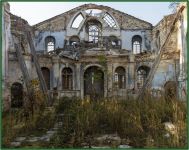Bài học cùng chủ đề
Báo cáo học liệu
Mua học liệu
Mua học liệu:
-
Số dư ví của bạn: 0 coin - 0 Xu
-
Nếu mua học liệu này bạn sẽ bị trừ: 2 coin\Xu
Để nhận Coin\Xu, bạn có thể:

Practice SVIP
Yêu cầu đăng nhập!
Bạn chưa đăng nhập. Hãy đăng nhập để làm bài thi tại đây!
Put the words/phrases into the correct columns.
- It's next to…
- It's on your left.
- Take the first road/turning on the right.
- Walk along … street/road.
- Turn left at the corner.
- Go straight ahead.
- It's just around the corner.
Movement
Location
Choose the correct answer to complete the sentences.
Excuse me, _______ is the Ho Chi Minh Mausoleum located?
Excuse me, can you tell me _______ to get to the Ancient Citadel?
Walk straight, _______ the bridge, and you'll see the entrance to the Imperial City.
Walk straight, then turn right _______ the traffic lights.
Go straight down this road, and you'll find it _______ your left.
Choose the correct answer to complete the sentences.
Sam: I'm looking for the Water Puppet Theater. _________________
Sarah: It's not far. Walk straight and turn right at the next intersection.
Tuan: Excuse me, _________________?
Nam: Certainly! Walk straight, cross the bridge, and you'll see the entrance to the Imperial City.
Alex: _________________
Rane: It's uphill. Take the bus from this station, and it will drop you off near the cable car.
Linh: Can you tell me how to get to the Cu Chi Tunnels?
Trang: Yes, it's a bit far. _________________
Fill in the blanks to complete the conversation.
Surie: Excuse me, I'm new here.
Joe: Of course! First, walk straight down this road until you see a large square. Ho Chi Minh Mausoleum is there.
Surie: And where's the Temple of Literature?
Joe: It's close. You'll spot the Temple of Literature.
Surie: Thanks!
Joe: Absolutely! Once you're done at the Temple of Literature, head straight, and you'll reach Hoan Kiem Lake. There's a lovely pagoda there too.
Surie: Perfect! How do I get back from the lake?
Joe: It creates a nice circular route.
Surie: Great!
Joe: No problem! Enjoy exploring Ho Chi Minh Mausoleum, Temple of Literature, and Hoan Kiem Lake!
Surie: I will. Thanks again!
(Kéo thả hoặc click vào để điền)
Look, read, and match.
 collaborate (v)
collaborate (v) flourish (v)
flourish (v) revive (v)
revive (v)Look, read, and match.
 abandonment (n)
abandonment (n) reconciliation (n)
reconciliation (n) credit (n)
credit (n) manuscript (n)
manuscript (n)Read the passage and choose the correct answer.
UNESCO has made a lot of efforts to preserve cultural heritage worldwide.
Abu Simbel
The Temple of the Rising Sun was rediscovered in 1813 and later faced underwater destruction from the Aswan High Dam. In 1964, UNESCO launched a unique campaign to save Egypt's temples. Experts from 50 nations cooperated to move the entire site to a new location, ensuring preservation for future generations. International cooperation's success in saving Abu Simbel raised awareness about protecting valuable places worldwide from threats like conflict, destruction, and climate change.
Venice
Rising sea levels threaten Venice; flooding and humidity damage the city's foundations. Since 1966, UNESCO and Italy have collaborated on a project using giant floodgates to protect Venice from high tides. Venice still requires careful attention for its survival because it faces threats from mass tourism, urban development, and huge cruise ships. International pressure led to a 2021 ban on large vessels in the city center to protect Venice's environmental, artistic, and cultural integrity. This decision followed UNESCO's intent to list Venice as its World Heritage in Danger.
Angkor Wat
Angkor Wat faced abandonment and hiding by forests due to floods and droughts around 1500 A.D. Rediscovered in 1860, by the early 1990s, the site faced threats, including temple collapse and looting. Including Angkor Wat in UNESCO's World Heritage List in 1992 marked a crucial step in Cambodia's recovery from years of conflict. UNESCO's support aimed at helping nation-building and reconciliation. The removal from UNESCO's List of World Heritage in Danger just fourteen years later is a credit to the Cambodian people.
Stari Most
The Old Bridge (Stari Most) is the most attractive destination in Mostar. This bridge historically unified diverse communities, but its intentional destruction in 1993 aimed to divide them. Five years later, UNESCO coordinated a reconstruction project to rebuild the Old Bridge. Despite the scars of the war that are still visible today on the city walls, the reconstructed bridge has become a symbol of reconciliation and post-conflict healing. Included on UNESCO's World Heritage list in 2006, Stari Most today is a bridge between a common past and a common future.
Timbuktu
Timbuktu flourished in the 16th century and held 700,000 manuscripts reflecting Africa's rich history. In 2012–2013, over 4,000 manuscripts were lost, and 10,000 were at risk. To preserve this heritage, UNESCO supports local communities in manuscript conservation and rebuilding mausoleums and mosques, fostering reconciliation and reviving building traditions. Workers used traditional methods and local materials to ensure the rebuilt shrines looked like the old ones. The monuments in Timbuktu today are living heritage sites closely associated with religious rituals and community gatherings.
Which site was recognized as a World Heritage site in the early 90s of the last century?
Which site has a strong connection to religion and community gatherings?
Which site was relocated in order to stay intact?
Which site was reconstructed with regional resources?
Which site was intentionally destroyed for the purpose of division?
Which site was adversely impacted by transportation?
Read the passage again and write the correct answer. No more than TWO WORDs in each blank.
UNESCO has made a lot of efforts to preserve cultural heritage worldwide.
Abu Simbel
The Temple of the Rising Sun was rediscovered in 1813 and later faced underwater destruction from the Aswan High Dam. In 1964, UNESCO launched a unique campaign to save Egypt's temples. Experts from 50 nations cooperated to move the entire site to a new location, ensuring preservation for future generations. International cooperation's success in saving Abu Simbel raised awareness about protecting valuable places worldwide from threats like conflict, destruction, and climate change.
Venice
Rising sea levels threaten Venice; flooding and humidity damage the city's foundations. Since 1966, UNESCO and Italy have collaborated on a project using giant floodgates to protect Venice from high tides. Venice still requires careful attention for its survival because it faces threats from mass tourism, urban development, and huge cruise ships. International pressure led to a 2021 ban on large vessels in the city center to protect Venice's environmental, artistic, and cultural integrity. This decision followed UNESCO's intent to list Venice as its World Heritage in Danger.
Angkor Wat
Angkor Wat faced abandonment and hiding by forests due to floods and droughts around 1500 A.D. Rediscovered in 1860, by the early 1990s, the site faced threats, including temple collapse and looting. Including Angkor Wat in UNESCO's World Heritage List in 1992 marked a crucial step in Cambodia's recovery from years of conflict. UNESCO's support aimed at helping nation-building and reconciliation. The removal from UNESCO's List of World Heritage in Danger just fourteen years later is a credit to the Cambodian people.
Stari Most
The Old Bridge (Stari Most) is the most attractive destination in Mostar. This bridge historically unified diverse communities, but its intentional destruction in 1993 aimed to divide them. Five years later, UNESCO coordinated a reconstruction project to rebuild the Old Bridge. Despite the scars of the war that are still visible today on the city walls, the reconstructed bridge has become a symbol of reconciliation and post-conflict healing. Included on UNESCO's World Heritage list in 2006, Stari Most today is a bridge between a common past and a common future.
Timbuktu
Timbuktu flourished in the 16th century and held 700,000 manuscripts reflecting Africa's rich history. In 2012–2013, over 4,000 manuscripts were lost, and 10,000 were at risk. To preserve this heritage, UNESCO supports local communities in manuscript conservation and rebuilding mausoleums and mosques, fostering reconciliation and reviving building traditions. Workers used traditional methods and local materials to ensure the rebuilt shrines looked like the old ones. The monuments in Timbuktu today are living heritage sites closely associated with religious rituals and community gatherings.
Success in saving Abu Simbel increased global awareness about safeguarding important sites from conflicts, destruction, and .
Since 1966, UNESCO and Italy have used to shield Venice from high tides, but ongoing threats remain.
It is a(n) to the people of Cambodia that Angkor Wat was taken off UNESCO's endangered list after 14 years of restoration work.
The Old Bridge connects the past and future and represents healing and after a conflict, despite obvious signs of conflict.
